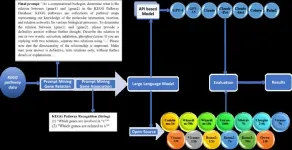(Press-News.org) Washington, July 11, 2024—Predictive algorithms commonly used by colleges and universities to determine whether students will be successful may be racially biased against Black and Hispanic students, according to new research published today in AERA Open, a peer-reviewed journal of the American Educational Research Association. The study—conducted by Denisa Gándara (University of Texas at Austin), Hadis Anahideh (University of Illinois Chicago), Matthew Ison (Northern Illinois University), and Lorenzo Picchiarini (University of Illinois Chicago)—found that predictive models also tend to overestimate the potential success of White and Asian students.
Video: Co-authors Denisa Gándara and Hadis Anahideh discuss findings and implications of the study
“Our results show that predictive models yield less accurate results for Black and Hispanic students, systemically making more errors,” said study co-author Denisa Gándara, an assistant professor in the College of Education at the University of Texas at Austin.
These models incorrectly predict failure for Black and Hispanic students 19 percent and 21 percent of the time, respectively, compared to false negative rates for White and Asian groups of 12 percent and 6 percent. At the same time, the models incorrectly predict success for White and Asian students 65 percent and 73 percent of the time, respectively, compared to false negative rates for Black and Hispanic students of 33 percent and 28 percent.
“Our findings reveal a troubling pattern—models that incorporate commonly used features to predict success for college students end up forecasting worse outcomes for racially minoritized groups and are often inaccurate,” said co-author Hadis Anahideh, an assistant professor of industrial engineering at the University of Illinois Chicago. “This underscores the necessity of addressing inherent biases in predictive analytics in education settings.”
The study used nationally representative data spanning 10 years from the U.S. Department of Education’s National Center for Education Statistics, including 15,244 students.
Findings from the study also point to the potential value of using statistical techniques to mitigate bias, although there are still limitations.
“While our research tested various bias-mitigation techniques, we found that no single approach fully eliminates disparities in prediction outcomes or accuracy across different fairness notions,” said Anahideh.
Higher education institutions are increasingly turning to machine learning and artificial intelligence algorithms that predict student success to inform various decisions, including those related to admissions, budgeting, and student-success interventions. In recent years, there have been concerns raised that these predictive models may perpetuate social disparities.
“As colleges and universities become more data-informed, it is imperative that predictive models are designed with attention to their biases and potential consequences,” said Gándara. “It is critical for institutional users to be aware of the historical discrimination reflected in the data and to not penalize groups that have been subjected to racialized social disadvantages.”
The study’s authors noted that the practical implications of the findings are significant but depend on how the predicted outcomes are used. If models are used to make college admissions decisions, admission may be denied to racially minoritized students if the models show that previous students of the same racial categories had lower success. Higher education observers have also warned that predictions could lead to educational tracking, encouraging Black and Hispanic students to pursue courses or majors that are perceived as less challenging.
On the other hand, biased models may lead to greater support for disadvantaged students. By falsely predicting failure for racially minoritized students who succeed, the model may direct greater resources to those students. Even then, Gándara noted, practitioners must be careful not to produce deficit narratives about minoritized students, treating them as though they had a lower probability of success.
“Our findings point to the importance of institutions training end users on the potential for algorithmic bias,” said Gándara. “Awareness can help users contextualize predictions for individual students and make more informed decisions.”
She noted that policymakers might consider policies to monitor or evaluate the use of predictive analytics, including their design, bias in predicted outcomes, and applications.
Funding note: This research was supported by the Institute of Education Sciences at the U.S. Department of Education
Study citation: Gándara, D., Anahideh, H., Ison, M., & Picchiarini, L. (2024). Inside the black box: Detecting and mitigating algorithmic bias across racialized groups in college student-success prediction. AERA Open, 10(1), 1–15. https://doi.org/10.1177/23328584241258741
###
About AERA
The American Educational Research Association (AERA) is the largest national interdisciplinary research association devoted to the scientific study of education and learning. Founded in 1916, AERA advances knowledge about education, encourages scholarly inquiry related to education, and promotes the use of research to improve education and serve the public good. Find AERA on Facebook, X, LinkedIn, Instagram, Threads, and Bluesky.
END
Study: Algorithms used by universities to predict student success may be racially biased
Predictive algorithms underestimate the likely success of Black and Hispanic students
2024-07-11
ELSE PRESS RELEASES FROM THIS DATE:
Comprehensive evaluation of large language models in mining gene relations and pathway knowledge
2024-07-11
Understanding complex biological pathways, such as gene-gene interactions and gene regulatory networks, is crucial for exploring disease mechanisms and advancing drug development. However, manual literature curation of these pathways cannot keep pace with the exponential growth of discoveries. Large-scale language models (LLMs) trained on extensive text corpora contain rich biological information and can be leveraged as a biological knowledge graph for pathway curation.
Recently, Quantitative Biology published a study titled "A Comprehensive ...
Researchers pinpoint brain cells that delay first bite of food
2024-07-11
LA JOLLA, CA—Do you grab a fork and take a first bite of cake, or say no and walk away? Our motivation to eat is driven by a complex web of cells in the brain that use signals from within the body, as well as sensory information about the food in front of us, to determine our behaviors. Now, Scripps Research scientists have identified a group of neurons in a small and understudied region of the brain—the parasubthalamic nucleus (PSTN)—that controls when an animal decides to take a first bite of food.
In the study, published in Molecular Psychiatry on July 4, 2024, the team of scientists set out to selectively manipulate a group of PSTN cells that dial up their ...
With spin centers, quantum computing takes a step forward
2024-07-11
RIVERSIDE, Calif. -- Quantum computing, which uses the laws of quantum mechanics, can solve pressing problems in a broad range of fields, from medicine to machine learning, that are too complex for classical computers. Quantum simulators are devices made of interacting quantum units that can be programmed to simulate complex models of the physical world. Scientists can then obtain information about these models, and, by extension, about the real world, by varying the interactions in a controlled way and measuring the resulting behavior of the quantum simulators.
In a paper published in Physical Review B, a UC Riverside-led research team ...
Scientists release new research on planted mangroves’ ability to store carbon
2024-07-11
U.S. Forest Service ecologists and partners published new findings on how planted mangroves can store up to 70% of carbon stock to that found in intact stands after only 20 years.
Researchers have long known that mangroves are superstars of carbon absorption and storage. But until now, limited information existed on how long it took for carbon stored in planted mangroves to reach levels found in intact mangroves.
“About ten years ago, Sahadev Sharma, then with the Institute of Pacific Islands Forestry, and I discovered that 20-year-old mangrove plantations in Cambodia had carbon stocks comparable to those of intact forests,” ...
New immune cell therapy benefits laboratory models of ALS and has some positive results in an individual with the disease
2024-07-11
Immune system dysregulation and elevated inflammation contribute to the development of the fatal neurodegenerative condition amyotrophic lateral sclerosis (ALS), also known as Lou Gehrig's disease.
In new research published in The FASEB Journal, repeated infusions of certain immune cells delayed ALS onset and extended survival in mice, and also reduced markers of inflammation in an individual with the disease. The work was conducted by investigators at Massachusetts General Hospital, a founding member of the Mass General ...
Trial of cell-based therapy for high-risk lymphoma leads to FDA breakthrough designation
2024-07-11
CAR-T cell therapy, which targets a specific protein on the surface of cancer cells, causes tumors to shrink or disappear in about half of patients with large B-cell lymphoma who haven’t experienced improvement with chemotherapy treatments.
But if this CAR-T treatment fails, or the cancer returns yet again — as happens in approximately half of people — the prognosis is dire. The median survival time after relapse is about six months.
Now, a phase 1 clinical trial at Stanford Medicine ...
Major trial looks at most effective speech therapy for people with Parkinson’s disease
2024-07-11
A major clinical trial, led by experts at the University of Nottingham, has shown the Lee Silverman Voice Treatment (LSVT LOUD®) is more effective than the current speech and language therapy provided by the NHS, when treating patients with Parkinson’s disease (PD).
The results of the NIHR HTA funded trial, which are published today in the BMJ, showed that LSVT LOUD® was more effective at reducing the participant’s reported impact of voice problems than no speech and language therapy, as well as the NHS delivered speech and language therapy.
The trial was led by experts from the Universities of Nottingham and Birmingham, ...
Intensive voice treatment more effective than NHS speech therapy for Parkinson’s disease
2024-07-11
An intensive voice treatment developed in the USA and known as the Lee Silverman voice treatment (LSVT LOUD) is more effective than conventional NHS speech and language therapy or no therapy for people with Parkinson’s disease, finds a trial published in The BMJ today.
The researchers say the results emphasise the need to optimise the use of speech and language therapy resources for people with Parkinson’s disease.
Slurred or slow speech (known as dysarthria) is a common feature of Parkinson’s disease and can have a significant effect ...
NHS’s relentless focus on finance and productivity is failing patient safety
2024-07-11
“The NHS’s relentless focus on finance and productivity is failing patient safety,” argues patient safety commissioner Henrietta Hughes in an interview for The BMJ today.
“The patient’s anecdote is the canary in the coal mine,” she says. It’s the thing that tells us there’s something going wrong. But too often we hear about patients who have raised concerns being gaslighted, dismissed, and fobbed off.”
Hughes, a GP and former medical director at NHS England, became England’s first independent patient safety commissioner in September 2022.
The job was created ...
World leaders unite to embed social participation in health systems
2024-07-11
For the first time in the World Health Organization’s 76 year history, world leaders have unanimously committed to put social participation - people, communities and civil society - at the heart of health decision making processes.
This landmark pledge marks an important step forward in creating a healthy world, say experts in The BMJ today, and they urge everyone to seize their right to influence the decisions that affect their health and well-being.
Global challenges such as access to care, climate change, widening ...
LAST 30 PRESS RELEASES:
First Editorial of 2026: Resisting AI slop
Joint ground- and space-based observations reveal Saturn-mass rogue planet
Inheritable genetic variant offers protection against blood cancer risk and progression
Pigs settled Pacific islands alongside early human voyagers
A Coral reef’s daily pulse reshapes microbes in surrounding waters
EAST Tokamak experiments exceed plasma density limit, offering new approach to fusion ignition
Groundbreaking discovery reveals Africa’s oldest cremation pyre and complex ritual practices
First breathing ‘lung-on-chip’ developed using genetically identical cells
How people moved pigs across the Pacific
Interaction of climate change and human activity and its impact on plant diversity in Qinghai-Tibet plateau
From addressing uncertainty to national strategy: an interpretation of Professor Lim Siong Guan’s views
Clinical trials on AI language model use in digestive healthcare
Scientists improve robotic visual–inertial trajectory localization accuracy using cross-modal interaction and selection techniques
Correlation between cancer cachexia and immune-related adverse events in HCC
Human adipose tissue: a new source for functional organoids
Metro lines double as freight highways during off-peak hours, Beijing study shows
Biomedical functions and applications of nanomaterials in tumor diagnosis and treatment: perspectives from ophthalmic oncology
3D imaging unveils how passivation improves perovskite solar cell performance
Enriching framework Al sites in 8-membered rings of Cu-SSZ-39 zeolite to enhance low-temperature ammonia selective catalytic reduction performance
AI-powered RNA drug development: a new frontier in therapeutics
Decoupling the HOR enhancement on PtRu: Dynamically matching interfacial water to reaction coordinates
Sulfur isn’t poisonous when it synergistically acts with phosphine in olefins hydroformylation
URI researchers uncover molecular mechanisms behind speciation in corals
Chitin based carbon aerogel offers a cleaner way to store thermal energy
Tracing hidden sources of nitrate pollution in rapidly changing rural urban landscapes
Viruses on plastic pollution may quietly accelerate the spread of antibiotic resistance
Three UH Rainbow Babies & Children’s faculty elected to prestigious American Pediatric Society
Tunnel resilience models unveiled to aid post-earthquake recovery
Satellite communication systems: the future of 5G/6G connectivity
Space computing power networks: a new frontier for satellite technologies
[Press-News.org] Study: Algorithms used by universities to predict student success may be racially biasedPredictive algorithms underestimate the likely success of Black and Hispanic students



